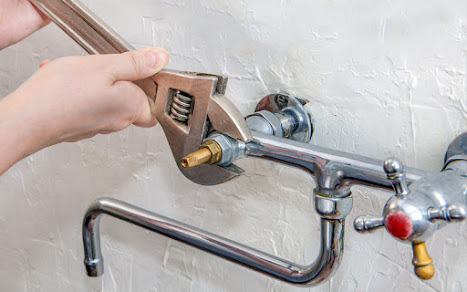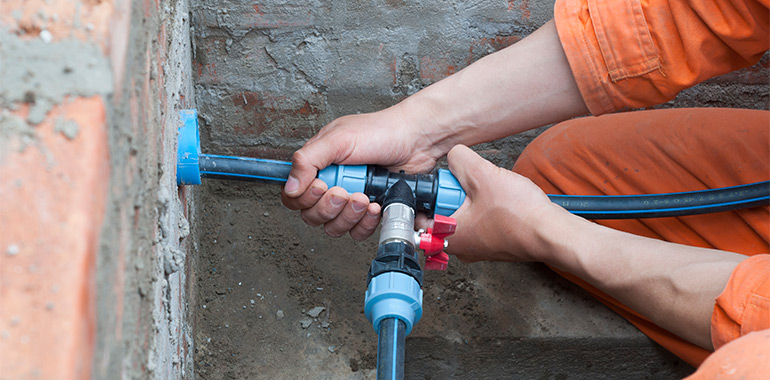This post in the next paragraphs on the subject of How To Fix Noisy Pipes is absolutely remarkable. You should investigate for yourself.

To identify noisy plumbing, it is important to figure out very first whether the unwanted sounds take place on the system's inlet side-in other words, when water is transformed on-or on the drainpipe side. Sounds on the inlet side have actually differed causes: too much water pressure, used valve and tap parts, improperly linked pumps or other devices, incorrectly positioned pipe fasteners, and also plumbing runs including way too many limited bends or other restrictions. Sounds on the drain side usually come from poor place or, just like some inlet side noise, a design containing tight bends.
Hissing
Hissing noise that takes place when a faucet is opened somewhat generally signals extreme water pressure. Consult your regional water company if you presume this problem; it will have the ability to tell you the water stress in your area as well as can mount a pressurereducing valve on the inbound water supply pipe if required.
Thudding
Thudding sound, frequently accompanied by trembling pipes, when a faucet or device valve is shut off is a problem called water hammer. The sound and also resonance are triggered by the resounding wave of pressure in the water, which all of a sudden has no area to go. Sometimes opening a shutoff that releases water rapidly right into an area of piping containing a constraint, joint, or tee installation can produce the exact same problem.
Water hammer can usually be cured by setting up installations called air chambers or shock absorbers in the plumbing to which the trouble valves or faucets are linked. These devices enable the shock wave produced by the halted circulation of water to dissipate airborne they have, which (unlike water) is compressible.
Older plumbing systems might have short upright areas of capped pipe behind walls on tap runs for the very same objective; these can ultimately full of water, reducing or destroying their efficiency. The remedy is to drain pipes the water system completely by turning off the main supply of water shutoff and also opening all faucets. After that open up the main supply valve as well as shut the taps one at a time, beginning with the tap nearest the valve and ending with the one farthest away.
Babbling or Shrilling
Extreme chattering or screeching that occurs when a valve or tap is activated, and that typically vanishes when the installation is opened totally, signals loose or malfunctioning inner components. The remedy is to change the shutoff or tap with a brand-new one.
Pumps and appliances such as washing machines and dishwashers can transfer motor noise to pipelines if they are poorly attached. Connect such products to plumbing with plastic or rubber hoses-never rigid pipe-to isolate them.
Other Inlet Side Noises
Squeaking, squealing, damaging, breaking, as well as tapping typically are brought on by the development or tightening of pipelines, usually copper ones providing hot water. The noises occur as the pipelines slide versus loosened fasteners or strike nearby house framing. You can often determine the location of the trouble if the pipelines are subjected; just follow the audio when the pipelines are making noise. Most likely you will uncover a loosened pipe hanger or a location where pipelines lie so near flooring joists or various other framing pieces that they clatter against them. Attaching foam pipe insulation around the pipelines at the point of call need to correct the problem. Make certain straps and also wall mounts are protected and give sufficient support. Where feasible, pipeline bolts should be affixed to large structural components such as structure walls as opposed to to framing; doing so lessens the transmission of resonances from plumbing to surfaces that can enhance and also transfer them. If attaching bolts to framing is inescapable, wrap pipelines with insulation or other resistant product where they contact fasteners, and sandwich completions of new bolts between rubber washing machines when installing them.
Dealing with plumbing runs that struggle with flow-restricting limited or various bends is a last resort that should be taken on just after speaking with a knowledgeable plumbing service provider. Sadly, this circumstance is fairly typical in older residences that may not have actually been built with interior plumbing or that have actually seen numerous remodels, especially by novices.
Drain Noise
On the drainpipe side of plumbing, the chief goals are to remove surfaces that can be struck by dropping or hurrying water and to insulate pipes to consist of unavoidable sounds.
In brand-new construction, tubs, shower stalls, commodes, and also wallmounted sinks and basins ought to be set on or versus resilient underlayments to decrease the transmission of noise via them. Water-saving commodes and faucets are less noisy than traditional designs; mount them as opposed to older kinds even if codes in your location still allow making use of older components.
Drains that do not run up and down to the basement or that branch into horizontal pipe runs supported at floor joists or other framing existing specifically troublesome noise problems. Such pipes are big enough to radiate significant resonance; they likewise bring considerable quantities of water, that makes the situation even worse. In brand-new construction, define cast-iron dirt pipelines (the huge pipelines that drain pipes commodes) if you can manage them. Their enormity contains much of the noise made by water passing through them. Also, stay clear of transmitting drains in wall surfaces shown to bed rooms as well as spaces where people collect. Wall surfaces consisting of drains ought to be soundproofed as was explained earlier, using double panels of sound-insulating fiber board and also wallboard. Pipelines themselves can be covered with special fiberglass insulation made for the function; such pipes have an impervious vinyl skin (occasionally having lead). Outcomes are not always acceptable.
DIAGNOSE UNWANTED PLUMBING NOISES
Did You Hear That?
One of the first steps to take when diagnosing noisy plumbing is to determine whether the mysterious sound is occurring when your water is turned on or if it is a result of draining water. Noises on the inlet side (or when your water is turned on) could be caused by: excessive water pressure, worn valve or faucet parts, improperly connected pumps or other appliances, incorrectly placed pipe fasteners, and plumbing runs containing too many tight bends or other restrictions. Noises on the drain side usually stem from poor location or a possible pipe layout containing too many tight bends.
Hissing
A hissing noise that occurs when a faucet is opened slightly generally signals excessive water pressure. If you encounter hissing sounds call your locate water company, they will be able to tell you if the water pressure in your area may be the culprit. They can also install a pressure reducing valve on the incoming water supple pipe to help regulate the pressure.
Thudding
Thudding noise, often accompanied by shuddering pipes, when a faucet or appliance valve is turned off is a common condition referred to as a water hammer. The noise and vibration are caused by the reverberating wave of pressure in the water, which suddenly has no place to go. Opening a valve that discharges water at a rapid pace into a section of piping containing a restriction, elbow, or other fitting can also produce water hammer.
Water hammer can usually be cured by installing fittings called air chambers or shock absorbers in the plumbing to which the problem valves or faucets are connected. These devices allow the shock wave created by the halted flow of water to dissipate in the air they contain, which (unlike water) is compressible.
Older plumbing systems may have short vertical sections of capped pipe behind walls on faucet runs for the same purpose; these can eventually fill with water, reducing or destroying their effectiveness. The cure is to drain the water system completely by shutting off the main water supply valve and opening all faucets. Then open the main supply valve and close the faucets one at a time, starting with the faucet nearest the valve and ending with the one farthest away.
Chattering or Screeching
Intense chattering or screeching that occurs when a valve or faucet is turned on, and that usually disappears when the fitting is opened fully, signals loose or defective internal parts. In most cases, the only solution is to replace the defective valve or faucet with a new one.
Pumps and appliances such as washing machines and dishwashers can also transfer motor noise to pipes if they are improperly connected. When installing new appliances always link them to plumbing with plastic or rubber hoses and never use rigid pipe. This will dramatically cut down on the amount of noise create when the appliance is in use.
Other Mysterious Noises
Creaking, squeaking, scratching, snapping, and tapping noises are commonly caused by the expansion or contraction of copper pipes used to supply hot water. The sounds can occur as the pipes slide against loose fasteners or strike nearby house framing.
If you can pinpoint the problem by following the sound to an exposed pipe you may discover a lose pipe hanger or other obstruction that the pipes can clatter against. Attaching foam pipe insulation around the pipes at the contact points will lessen the transmission of vibration from plumbing to surfaces that can amplify the sounds.
When replacing or installing new pipe hangers try to fasten them to larger structural elements that will work to dampen or disperse the sound and always sandwich the ends of new fasteners between rubber washers.
Drain Pipe Noise
When dealing with noises produced by drain pipes the primary goal is to eliminate and surfaces that can be struck by falling water or rushing water and to insulate the pipes to contain any avoidable sounds.
When replacing toilets or faucets, inquire about water-saving alternatives as they are less noisy than conventional models. Upgrading your fixtures can be an easy solution to stubborn plumbing sounds.
When having old plumbing repaired or replaced avoid routing drain pipes in walls shared with bedrooms or rooms where your family and guests often gather. Walls containing drain pipes need to be soundproofed and the pipes themselves should be wrapped with specially designed fiberglass insulation.
https://www.horizonservices.com/about-us/blog/diagnose-unwanted-plumbing-noises/

Do you enjoy more info about Why Do My Pipes Make Noises? Try to leave a review down the page. We'd be glad to know your reactions about this review. We hope that you visit us again before long. Appreciated our content? Please share it. Let others locate it. Thanks a bunch for your time. Come back soon.
Get A Free Quote